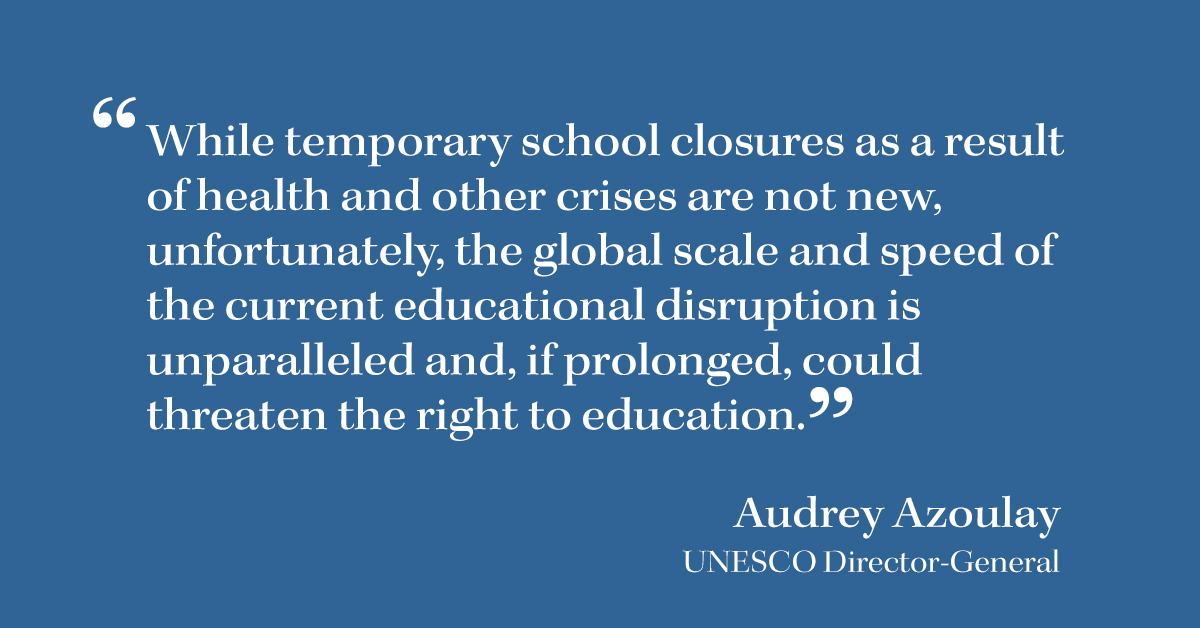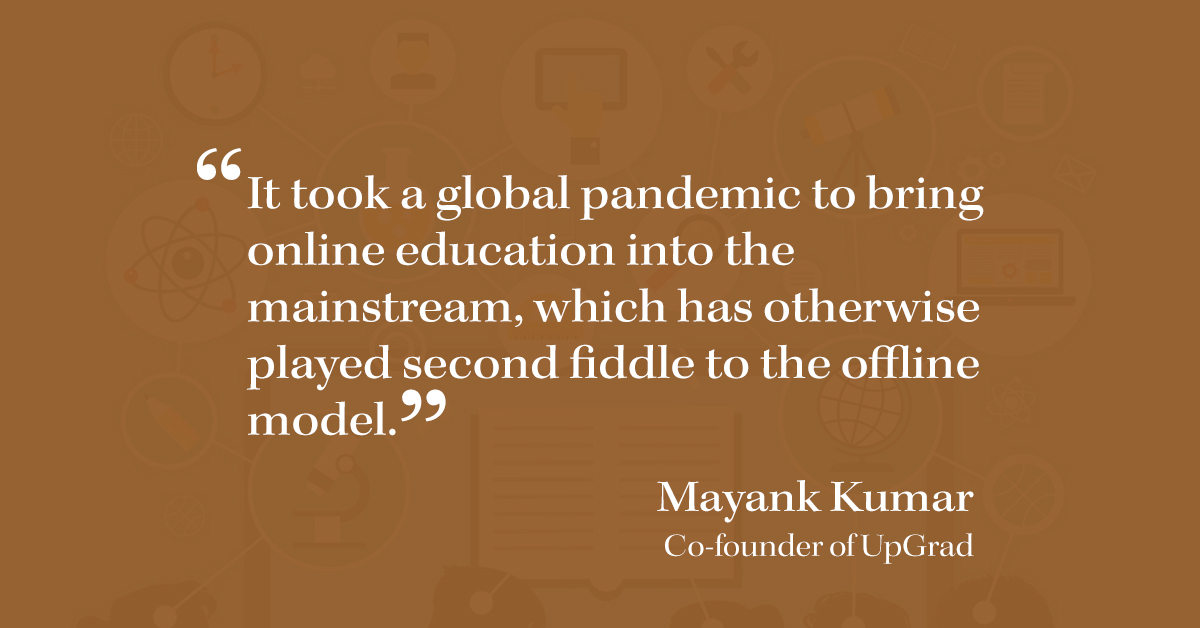Navigating the ongoing paradigm shift in the Indian education sector

Opportunities in the Indian Pharmaceutical Sector Post COVID-19
April 22, 2020
Supply Chain Resilience Initiative (SCRI)
May 3, 2020
Part 1: The current scenario & responses by offline and ed-tech players
The Indian government announced the nation-wide lockdown on March 24, 2020, bringing thousands of educational institutes’ operations to a halt for at least 21 days, and hence preventing India’s 260 million school and college going population from receiving their education. Several students are in the last stretch of their preparations for national competitive examinations such as JEE and NEET or their board exams, making this an extremely crucial time for both students and their families as well as schools and coaching institutes. Other individuals who were preparing for higher education examinations such as GRE and GMAT have also been thrown for a loop. Further, there is a sudden additional pressure on parents, especially of younger students, to ensure that their child’s studies are not disrupted, while at the same time manage their own work obligations.

There doesn’t seem to be any respite in sight anytime soon. According to the Union HRD Minister Ramesh Pokhriyal, the Indian government will take a decision on reopening of schools and colleges on April 14 after reviewing the Covid-19 situation in the country. With demands to keep the country in lockdown for a few more weeks after April 14, increasing every day, the situation appears bleak and indicates that the duration of these closures is still unknown.
With this uncertain background, both offline and ed-tech players have chalked out different priorities for themselves and have responded in different ways.
Offline players’ response
Offline players, such as pre-schools, primary and secondary schools, colleges and universities, and brick-and mortar coaching institutes, began by shifting their classes online. They bought video conferencing and webinar software such as Zoom and Webex to continue holding classes online. They are using a combination of live classes, recorded videos, online tests and assessment, in conjunction with physical textbooks to impart lessons.
On the other side, to keep the faculty and staff engaged and motivated, schools are using tools such as Microsoft Teams to hold frequent meetings. Some schools have also managed to bring other essential activities such as scheduling, vendor payment, and admission online through the usage of ERP systems. To equip faculty with the right hardware, some schools have purchased laptops and iPads and distributed them amongst teachers. They have also been given an allowance to purchase webcams and upgrade their data plans.
Brick and mortar coaching institutes have also made these changes. Several of these institutes had already begun their migration to online and therefore, had already put in place mobile applications, which students could use to attempt assignments and mock tests. These applications also have a Parent Connect version that parents can use to monitor their children’s progress and performance.
Ed-tech players’ response
Ed-tech players such as BYJU’S, Vedantu and Unacademy, on the other hand, have been on an advertising spree in a bid to acquire as many new customers as possible. To get maximum people to sample their courses, several ed-tech companies such as BYJU’S, Vendantu, Unacademy, Toppr, Testbook, and Upgrad have made their courses free for all. These courses include live classes, recorded videos, doubt resolution, and online assignments and tests. This strategy has allowed ed-tech companies to onboard customers from Tier 2 and 3 towns, where the schools may not have the required IT infrastructure to deliver classes online.

This strategy has also been followed by global players such as Coursera. Coursera has mentioned that it would provide every university in the world, including India, free access to its course catalogue through Coursera for Campus till July 31, 2020.
In addition to making their content library available for free, companies such as Vedantu are also engaging with students over social media. It has launched a #21DayLearningChallenge under which influencers are challenging people to learn something new and then post about their experience on social media.
In order to meet this increased demand, these companies are also hiring more faculty. For example, Lido Learning has decided to hire over 500 online tutors across the country for the month of April to ensure continuous services to their customers.
It is fair to say that the Covid-19 pandemic has accelerated the acceptance rate of ed-tech solutions among the Indian population, and both the offline and online players need to adjust to this new reality.

Part 2: Recommendations for offline players
Due to the speed at which things have changed, offline players have had to adjust almost overnight. We have provided some recommendations that will facilitate these players to provide remote learning.
1. Conduct an audit of your existing capabilities and resources: School, college, and coaching institutions should first take a note of their existing capabilities and resources to go online or provide remote learning. This should include an evaluation of the available technologies and delivery mechanisms. The evaluation should be done in two phases: one, to check the organization’s readiness to respond in the short-term i.e. when the country is in lockdown; second, for when the schools can re-open. To understand about external solutions, organizations should consult with ed-tech start-ups and the Ministry of Electronics and Information Technology representatives. Ensure that the solutions consider the digital savviness of the target audience. For example, if the students are based in a Tier 2 or 3 city, remember to consider that your students may not have access to high-speed internet or sophisticated smart devices.
2. Check which part of your curriculum can be migrated online: During the audit, also check whether the teaching content in your curriculum can be migrated online. Further, plan how you can translate offline content (in the form of physical notes) into online content (for ex, videos and audios). If possible, equip your teaching faculty with the audio-visual tools (such as laptops and smartphones) that they can use to record themselves explaining concepts, which can then be circulated amongst the students. Organizations should also reach out to digital content creators such as BYJU’S and partner with them to provide content to fill in the gaps. There are also several government of India initiatives that can be investigated. For example, India’s National Repository of Open Educational Resources has content curated from CIET and NCERT, India. Schools and colleges can also consider Khan Academy, which offers question banks and videos for learning purposes, covering a gamut of topics including languages, arts, STEM, social studies, and humanities.
3. Organize the order in which the online content should be delivered: It might be the case that the content that has been sourced from external parties, does not fit exactly with your existing curriculum. It is extremely important to decide the order in which this content as well newly developed in-house content be delivered to the students to ensure that the educational objectives are met.
4. Create an online helpdesk for students, parents and faculty: Since this mode of delivery is new for all stakeholders, it is extremely important to set-up an online helpdesk that can answer queries as and when they arrive. This is required to keep all stakeholders engaged during the entire process and to ensure the required results.
5. Provide a one–stop-shop for all the content: The organisations should create a central learning system that can provide a consolidated view of all the content and tools available, as well as act as a place where the organization can post general notifications. Schools and colleges that already have learning management systems in place can further integrate them with technologies such as the video conferencing tools such as Zoom and Google Hangouts. For example, Moodle is a free open source platform that is used for blended learning, distance education, flipped classroom and other e-learning projects in schools, university, workplaces and other sectors. Another tool that is available is Google Classroom. This tool, developed by Google, supports online classroom experience for teachers and students. It allows other features as well such as online assessments, administration, scoring and feedback.
6. Ensure that content is mobile-friendly: If possible, the organization should ensure that the content can be viewed on mobile-devices such as smartphones and tabs. This is because a vast majority of people would be having smartphones or tabs rather than laptops or PCs. Ensuring that your content is mobile-friendly would allow it to be viewed by a larger population. Simple tools such as WhatsApp can be used to deliver lessons (in audio or video format), share assignments, and provide real-time doubt solving.
7. Support low-bandwidth / offline solutions: Schools and colleges should focus on creating low bandwidth requiring solutions, for example PDF documents that can be downloaded once and can be viewed offline or test and assignments that can be downloaded and attempted offline and later the attempt can be uploaded online, hence ensuring that the student does need to be online throughout the activity. For example, ePathshala is a portal for ebooks for school education for all subjects. It is available provided by NCERT and is available offline.
Part 3: Recommendations for ed-tech players
As offline players are scrambling to migrate online, ed-tech players have been using this opportunity to market their products aggressively. Many are wondering whether the Covid-19 pandemic will be for ed-tech companies what demonetization was for digital payment companies. Below we have provided some recommendations on how online players should be approaching the current situation.
1. Focus on building long-term partnerships along with short-term gains: Online players should use this opportunity to build long-term partnerships and capabilities, instead of just focusing on increasing their top lines. Most of the ed-tech companies have already started investing in increasing their brand awareness and market share through advertising and PR campaigns. One area that companies can focus on is getting an in-depth understanding of the needs and wants of all the stakeholders in the education sector, from schools and colleges to parents to policymakers These companies should be engaging with government ministries, and industry associations to understand how they can upgrade their products to better satisfy the needs of students, parents, and teachers.
2. Invest in educating people about their platforms: Since currently, most of the ed-tech players are competing using similar strategies of aggressive marketing and free access to content, one area that might act as a differentiating factor will be educating people on how to use their platforms. It is fair to assume that in these turbulent times, people will gravitate towards the platform that is easiest to use. Hence, it is essential for companies to put in the effort to familiarise people with how to operate their platforms and apps. This can be done through ads that provide a basic understanding of how to operate a platform or app or through personal discussions with school and college management followed by a virtual webinar with the students. This hand holding in the beginning will go a long way in building trust and familiarity with the company.
3. Onboard teachers and counsellors: As there has been a sudden surge in the number of users on these platforms, companies should invest in onboarding additional teachers and counsellors to ensure comprehensive lectures and content. It may be particularly important to onboard staff who can communicate in vernacular languages since these platforms are witnessing new users from India’s tier 2 and 3 cities.
4. Respond in an agile manner: This recommendation once again comes from the fact that schools and students will continue to engage with companies who respond in a quick and agile manner to their needs and queries. Since it’s highly probable that once finalized, schools will stick to the platforms till the end of the academic year or maybe even the beginning of the new academic year if the lockdown continues for long, ed-tech companies should put in effort to ensure high quality results in the first go.
5. Offer a one-stop-shop solution: A company that offers end-to-end solutions, including delivery course material, assessment, result declaration, and feedback sharing, would be preferable to students, parents, and teachers. This would also increase the probability of the platform being adopted post the Covid19 situation as well.
6. Provide your platform and resources for use by school faculty: Companies can offer their platforms and tools to schools and colleges faculty, who can use them to create their own content and videos. For example, Vedantu has partnered with schools in Bengaluru, Hyderabad, Delhi and parts of Kerala to facilitate teachers to conduct live classes from their homes. The company is allowing schools to create their own content, use their own teachers and conduct end-to-end classes through its platform. Similarly, Unacademy has allowed education institutes to use their platform to conduct classes for free, without any limitations on the hours or number of classes. Unacademy is also providing support to these institutes to set-up their live classes on Unacademy’s platform.
7. Ramp up security infrastructure and processes: With such a surge of new users, both individual and institutional, ed-tech companies need to ensure that their cybersecurity infrastructure and processes are robust. This is especially important keeping in mind that there is a large amount of children’s data involved. Additionally, schools who conduct their classes through third-party platforms would want their curriculum content and delivery videos to remain secure.
Part 4: Impact on the future
It is safe to say that once the Covid-19 pandemic gets over, the education sector as well as people’s learning habits would have been transformed. We believe that the following three areas will be majorly impacted:
1. Change in people’s mindset: This period of lockdown will give people enough time to play around and familiarise themselves with online learning. They will be able to judge for themselves the areas in which online learning was beneficial to In a way, this has and will continue to break down the psychological barrier in people’s minds that online learning is not as good as face-to-face learning. What is most important is that the parents, who are the purchasers of these services, would be able to see the effectiveness and ease of usage of ed-tech platforms as well as the vast range of content that their children can learn from.
2. Digitization of offline players: This lockdown has forced offline players such as schools, colleges and coaching institutes to digitize their entire student journey. Beginning from enrolment to class scheduling to conducting classes to assessments and feedback, all the steps are being conducted in an online set-up. These players are also becoming familiar with the types of tools and contents that are being offered by ed-tech players and in a way awakening them to the competitive threat that these players pose to them. On the other hand, they are also realising how these ed-tech companies can act as allies in some areas and overall enhance their offline offerings.
3. Personalization of ed-tech offerings and marketing: As mentioned above, ed-tech companies are witnessing a surge of new users on their platforms. This brings with it new customer data – data from the type of customers that they hadn’t served before. This customer data can be analysed and mined to reveal new customer segments and patterns. Companies can use this data to identify how students are behaving on their platforms and update their offerings to serve them better. On the other side, the vast amount of contact details that would be collected during this period, can be used to push targeted marketing campaigns that will have a reach across India.
In conclusion, we believe that by the time this pandemic ends, the entire landscape of the India education sector would have transformed and the need of the hour is for all stakeholders to take proactive steps to build their capabilities, so that they are prepared to take on the challenges of this “new normal” scenario.
References/citations:
- https://the-ken.com/story/schools-makeshift-covid-19-classes/
- https://the-ken.com/story/schools-makeshift-covid-19-classes/
- https://blog.unacademy.com/20-000-free-live-classes-stepping-up-in-the-face-of-the-covid-19-threat-7c05dc880403
- https://www.livemint.com/companies/news/covid-19-impact-online-learning-companies-see-spike-in-number-of-students-11584724448197.html
- http://www.telecomtoday.in/learning/vedantu-launched-21-day-learning-challenge-during-the-lockdown.html/
- https://www.whatsapp.com/coronavirus/educator/
- http://documents.worldbank.org/curated/en/531681585957264427/pdf/Guidance-Note-on-Remote-Learning-and-COVID-19.pdf / http://documents.worldbank.org/curated/en/964121585254860581/pdf/Remote-Learning-Distance-Education-and-Online-Learning-During-the-COVID19-Pandemic-A-Resource-List-by-the-World-Banks-Edtech-Team.pdf
- http://documents.worldbank.org/curated/en/266811584657843186/pdf/Rapid-Response-Briefing-Note-Remote-Learning-and-COVID-19-Outbreak.pdf
- https://tech.economictimes.indiatimes.com/news/internet/edutech-firms-offer-free-access-to-their-learning-platforms-amid-covid-19-outbreak/74580907
- https://www.livemint.com/companies/news/covid-19-impact-online-learning-companies-see-spike-in-number-of-students-11584724448197.html
Authored by: Aranya Kalia, Assistant Consultant
Contact details:

About Intueri: Intueri Consulting is a management consulting firm with nearly 100 man-years of experience in managing organizational challenges, including managing firms and clients through some of history’s biggest crisis periods such as the 1997 Asian Financial Crisis, 9/11 led crisis, 2007-08 global financial crisis. This vast repository of organizational management experience, accrued by senior management, over decades of managing large multinational firms and clients enables Intueri to develop effective, efficient crisis management strategies and provides it with a unique perspective into events and decisions that take into consideration all important aspects of a firm, including assessment of primary, secondary and even tertiary order potential effects on the firm on account of implementation of strategies. This article is consolidation of the experience and knowledge gained by Intueri’s consultants while working with education sector clients and is a demonstration of Intueri’s understanding about the Indian education sector and the paradigm shift it is going through.




